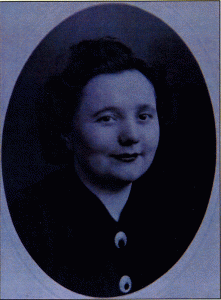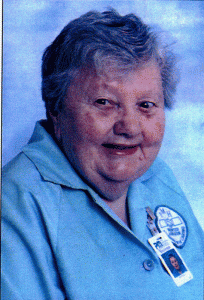Mother Goose
by Paul Nyznik

When Royal Air Force Corporal Molly Rayner was posted to 408 (Goose) Sqn RCAF soon after it was formed in Yorkshire in 1941, there began a relationship that has endured for almost 60 years. With her friendly, caring manner, her earthy humor and dedication to those who flew in the bomber squadron’s Hampdens, Halleys and Lancs, she quickly earned the sobriquet “Mother Goose.” It is a title she loves and wears proudly at every reunion 408 has held since 1968.
As Henrietta May Morgan, “Molly” was born in Maestag, South Wales, in 1919. “So English was not my first language,” she said. “In fact, some say that I still don’t speak it.” At 18, she began training as a nurse at the White-croft Mental Hospital on the Isle of Wight, but the war broke out just as she completed her preliminary examinations, and Molly decided to put her medical
career on hold and joined the RAF — as a cook.
“Later, when they found out about my training as a nurse, they wanted to reclassify me, but I was happy working in the kitchen and refused to remuster.”
At the squadron’s 1999 reunion in Ottawa she was asked to reminisce about her life on a wartime bomber squadron. Molly was off and running: “I was posted to 408 in Balderton, moved with the squadron to Leeming, and in August 1943 to Linton-on-Ouse. Nelles Timmerman was my first CO, Fred Sharp the last. In between there were seven others, including three who were killed on ops.
“MT driver Phyllis Cowie of Etobicoke, Ont, Rita ReIf, from somewhere in BC, and I were among the first of a very few females on the squadron. At that time, early in the war, young girls who joined the military were not well thought of by the general public. We were routinely described as: Ground-sheet, airmen for the use of…
“I always tried to help the boys, sewing buttons on their clothes and mending their socks. I had to stand on a box to serve the boys their favorite foods — powdered eggs, bangers and mash, bread pudding and their very favorite, Brussels sprouts!
“The Americans had these big rolls of bologna, which we had never seen before, so we called it ‘horse c—k.’ Now I think it’s referred to as ‘Newfie steak’.
“We had a discipline sergeant nicknamed ‘Night-Fighter Nolan’ because he used to sneak around on his bike, trying to catch the boys doing something wrong. This guy wore wings on his pyjamas! One night he and his bike were dumped into the River Ouse — and no one was ever charged.
“Sometimes, when the kitchen was closed, Nolan would demand that I prepare a meal for him. When I repeatedly refused, he had me transferred late in ‘44 to Hythe, Kent. It was there I met my husband, RCAF radar tech Don Rayner.
“Because I neither smoked nor drank, I was cheap to take out. The boys — Tommy Dimma, Ralph Shillington, Grant Willis and Bob Pridday — would meet me in the guardhouse to go into York to Betty’s Bar. Once there, if they picked up a girl, they would give me most of their money to look after before taking off.
“Tired of the Yanks always asking, ‘Any gum, chum?,’ one day we gave them our entire supply of Feena Mints, a laxative that looked like a pack of Wrigley’s Spearmint. What a laugh we had for the next couple of days!
“Whenever any of the local girls would call the mess, looking for one of the boys (sometimes in desperation, it seemed) we always told them he had been posted and we didn’t know where. “I was discharged on compassionate grounds. In other words, I was pregnant. They should have called it passionate grounds!”
Indelibly etched in her memory are the men, most still in or barely out of their teens, who were among the squadron’s 936 killed, missing or captured. Virtually taking sole responsibility for the well-being of the bomber crews, Molly would remain on duty in the kitchen until the last aircraft had returned after a raid, serving the exhausted crews a welcoming breakfast of bacon and eggs. There were poignant moments.
“I knew that while relationships between members of individual aircraft crews were often very close, it was not always so between them and the crews of other aircraft — whether from 408 or from a sister squadron sharing the same field. That was because the deep regret at losing a close, personal friend could be crushing, and so, as a defence mechanism, they would try to hide behind a display of bravado.
 “I recall early one morning the crews were returning from a sortie, one by one, landing, being debriefed, then making their way to the mess hall. I noticed this young lad, hanging back, his eyes sweeping the room. ‘Molly,’ he asked, ‘has Dan of “V” Vicki been in yet?” ‘No,’ I replied, ‘that crew has been reported missing.’ You could see the agony in his eyes — but only for a split second. Recovering, he asked, ‘Well then, can I have his egg?”
“I recall early one morning the crews were returning from a sortie, one by one, landing, being debriefed, then making their way to the mess hall. I noticed this young lad, hanging back, his eyes sweeping the room. ‘Molly,’ he asked, ‘has Dan of “V” Vicki been in yet?” ‘No,’ I replied, ‘that crew has been reported missing.’ You could see the agony in his eyes — but only for a split second. Recovering, he asked, ‘Well then, can I have his egg?”
Although diminutive in stature, Molly stands among the tallest in service to her community, as is evidenced by the citizenship awards which grace the walls of her Brampton, Ont, home. To mark the squadron’s 60th birthday, plans are afoot to hold a monster reunion in Edmonton in 2001. “Mother Goose” is already hatching plans to be there. (Ed note: Paul Nyznik of Nepean in suburban Ottawa is a former navigator with 408 Sqn.)

As one of the three daughters of Phyllis and Bill Cowie we knew the name of Molly. I’m sure we met somewhere and have several photos of her and my Mom on their reunion trips. Such wonderful friendships were formed during that terrible war. The 408 Goose squadron was a very large part of our parents lives.